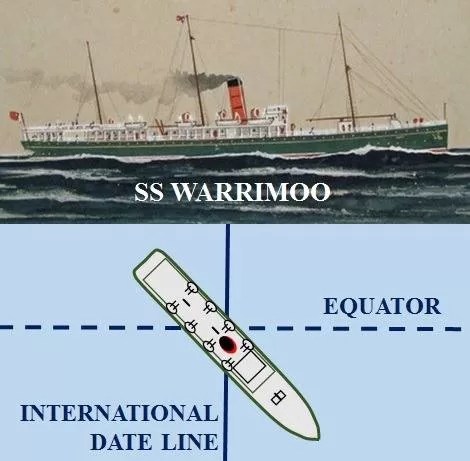In 1895, while facing significant financial challenges, Mark Twain embarked on a journey to Australia aboard the S.S. Warrimoo.

Twain’s sole means of rescuing his family from financial ruin was through writing and public speaking. He devised an extensive 13-month global lecture tour that would lead him from the United States to Canada, New Zealand, Australia, India, and eventually England.
In 1895, following Robert Louis Stevenson’s guidance to “sail west and take the first turn left,” with his wife, Olivia, and their middle daughter, Clara, by his side, Twain embarked on what he humorously termed “our lecturing raid around the world”.
During the long voyage aboard SS Warrimoo, he penned ‘Following the Equator,‘ his personal narrative of the expedition.
Within this work, he made an observation about the precise moment when the ship crossed the equator:
A sailor explained to a young girl that the ship’s speed is poor because we are climbing up the bulge toward the center of the globe; but that when we should once get over, at the equator, and start down-hill, we should fly.
Afternoon. Crossed the equator. In the distance it looked like a blue ribbon stretched across the ocean. Several passengers kodak’d it.
Three days later, he describes crossing the international dateline:
While we were crossing the 180th meridian it was Sunday in the stern of the ship where my family were, and Tuesday in the bow where I was. They were there eating the half of a fresh apple on the 8th, and I was at the same time eating the other half of it on the 10th–and I could notice how stale it was, already.
The family were the same age that they were when I had left them five minutes before, but I was a day older now than I was then. The day they were living in stretched behind them half way round the globe, across the Pacific Ocean and America and Europe; the day I was living in stretched in front of me around the other half to meet it.
Along about the moment that we were crossing the Great Meridian a child was born in the steerage, and now there is no way to tell which day it was born on. The nurse thinks it was Sunday, the surgeon thinks it was Tuesday. The child will never know its own birthday.
It will always be choosing first one and then the other, and will never be able to make up its mind permanently. This will breed vacillation and uncertainty in its opinions about religion, and politics, and business, and sweethearts, and everything, and will undermine its principles, and rot them away, and make the poor thing characterless, and its success in life impossible.
According to legend, a few years later …
The passenger steamer SS Warrimoo was silently cutting through the mid-Pacific waters on its voyage from Vancouver to Australia. After a star fix calculation, the navigator presented Captain John DS. Phillips with the ship’s coordinates: LAT 0º 31′ N and LONG 179 30′ W. This occurred on December 31, 1899.
“See what this means?” First Mate Payton interjected, “We’re just a few miles from the intersection of the Equator and the International Date Line.”
Captain Phillips, with a mischievous sense of adventure, seized the opportunity for a remarkable navigational feat. He summoned his navigators to the bridge to verify the ship’s position, adjusted the course slightly to align precisely with the mark, and fine-tuned the engine speed. The calm weather and clear night favored their endeavor.

As the clock struck midnight, the SS Warrimoo rested on the Equator, right at the point where it intersected the International Date Line.
This unusual position had a series of intriguing consequences:
- The ship’s bow was in the Southern Hemisphere, experiencing the middle of summer.
- The stern was in the Northern Hemisphere, amid the middle of winter.
- In the aft part of the ship, the date was December 31, 1899.
- In the forward part, it was January 1, 1900.
This peculiar situation meant that the ship existed in:
- Two different days.
- Two different months.
- Two different years.
- Two different seasons.
- And even two different centuries, all at the same time!
Is the legend true? Snopes says its unproven.
Mark Twain in Australia
Mark Twain, the American author and humorist, visited Australia in the late 19th century. He embarked on a world tour in 1895, which included a stop in Australia. Twain is best known for his works such as “The Adventures of Tom Sawyer” and “The Adventures of Huckleberry Finn.”
During his time in Australia, Mark Twain gave lectures and public talks, sharing his wit and humor with Australian audiences. He traveled to various cities, including Sydney, Melbourne, Adelaide, and Brisbane, where he spoke on a wide range of topics and shared his experiences. His humorous and insightful observations on Australian culture, society, and politics were well-received by the Australian people.
Twain’s visit to Australia left a lasting impression, and his writings and speeches from this period provide valuable insights into the cultural and social landscape of Australia in the late 19th century. His observations and experiences during his time in Australia can be found in his travel writings and correspondence.
Mark Twain’s journey to Australia was just one part of his extensive travels around the world, during which he interacted with people from various cultures and backgrounds, and his writings often reflect his keen observations and humorous take on the world around him.
Related stories
Nautical Training Ship NTS Vernon anchors
Captain Cook’s ship Endeavour confirmed found in Newport Harbour, USA
Capt Cook’s Journal Aboard HMB Endeavour




